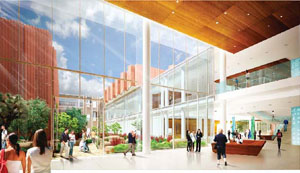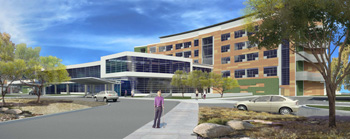Kaiser Permanente Recognizes Winners of Small Hospital Competition
 OAKLAND, Calif. — Kaiser Permanente selected Aditazz and a collaboration between Mazzetti Nash Lispey Burch (M+NLB) and Perkins+Will as the winners of its international Small Hospital, Big Idea competition. Gresham, Smith and Partners earned recognition as a finalist.
OAKLAND, Calif. — Kaiser Permanente selected Aditazz and a collaboration between Mazzetti Nash Lispey Burch (M+NLB) and Perkins+Will as the winners of its international Small Hospital, Big Idea competition. Gresham, Smith and Partners earned recognition as a finalist.
The contest required firms to design a small hospital and surrounding campus with net-zero energy consumption, suitable for a semi-rural area in Southern California, but adaptable to other areas. Net-zero energy consumption refers to the fact that a building provides all of its own energy from sustainable and/or renewable sources. As winners, Aditazz, M+NLB and Perkins+Will are eligible to contract with Kaiser for a small hospital project, tentatively planned for Southern California.
The Aditazz proposal features a three-story hospital with a partial fourth floor and 188 total beds. The design calls for a hospital featuring a “floating roof” over-arching canopy, covered by a large number of solar panels, which will contribute to energy savings and block the buildings below from various forms of exposure, lowering the costs and building requirements for them significantly.
 The Aditazz entry explained that this extra layer of protection from the effects of the sun will do some of the work usually accomplished by the facilities themselves, meaning, “the building envelope can be comprised of straight-forward, cost-effective materials and assemblies.”
The Aditazz entry explained that this extra layer of protection from the effects of the sun will do some of the work usually accomplished by the facilities themselves, meaning, “the building envelope can be comprised of straight-forward, cost-effective materials and assemblies.”
The proposal calls for a large courtyard, also under this protective canopy, allowing space for community events like farmers’ markets and providing outdoor seating for food services. The solar canopy in this area will be used as the framework for hanging banners, artwork and tapestries to enliven the space.
The MNLB collaboration with Perkins+Will calls for a three-story hospital with a maximum of 132 beds. The concept involves a Wellness Pavilion on the ground level, which doubles as the front door to the facility and will offer educational services. The area will also include retail space, as well as private dining facilities to increase the feel of melding public space with medical services to create a warm welcoming environment.
 Patient bathrooms are set along headwalls with continuous rails to reduce falls, while the patient’s rooms feature noise-reduction strategies to improve the quality of sleep. Smart bed technology allows the staff to monitor when patients leave their beds. The design features an energy use index approximately 75 percent lower than the regional average. This effect was achieved with solar energy, a high-performance envelope, ground-source heat pumps in place of boilers and a geothermal well-field instead of cooling towers.
Patient bathrooms are set along headwalls with continuous rails to reduce falls, while the patient’s rooms feature noise-reduction strategies to improve the quality of sleep. Smart bed technology allows the staff to monitor when patients leave their beds. The design features an energy use index approximately 75 percent lower than the regional average. This effect was achieved with solar energy, a high-performance envelope, ground-source heat pumps in place of boilers and a geothermal well-field instead of cooling towers.
The Gresham, Smith and Partners design includes automated guided vehicles (AVGs), essentially robots that transport materials throughout the facility. AVGs can be programmed to operate during off-peak hours, saving the funds required to pay four full-time employees. The facility achieves net-zero energy use by covering its parking lots with shade devices, featuring 300,000 square feet of solar panels, providing enough energy to power 75 percent of the hospital’s annual energy use. Either one large wind turbine or two smaller ones would be located in the northeast corner of the site, providing the rest of the power.
These are very forward-looking designs and the information provided here is merely the tip of the iceberg. Detailed proposals for all three designs can be found at http://design.kpnfs.com/winners.html
